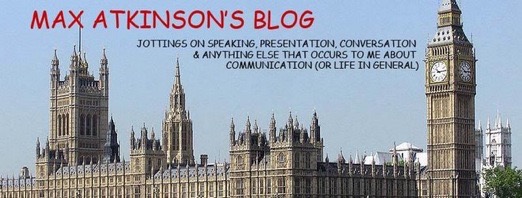Part of the answer is because their structure provides listeners with implicit instructions that enable them to anticipate exactly when the speaker will finish - so that they can be ready to respond as soon as he/she gets to the end (in much the same way as we're able to know when to respond in a conversation without interrupting or leaving a potentially embarrassing silence before we start to speak).
So, once someone in an audience notices that a speaker has launched into a contrast, it's pretty easy for them to recognise when the second part of it comes to an end. Or, if you hear a rhetorical question, you'll know that that you'll be able to respond as soon as the answer is completed.
In this sense, audience responses like booing, cheering and clapping are collective versions of the individual turns we take when talking to someone in a conversation (on which there's much more in my books!).
It's not often that television editors let us see members of an audience visibly anticipating one of these completion points, though I've already posted a very clear example of a woman anticipating the answer to a question being posed by David Cameron (HERE).
On BBC Question Time last night, there was a similar example of a listener anticipating the third item in a three-part list as the person in front of her was putting a question to the leader of the BNP.
As he launches into his list, watch the woman behind him on the left, and you'll see her nodding in approval just as he starts the third item in his list - which is also exactly the point at which the applause begins:
Where do you want me to go?
This is my country
I love this country
I'm part of this country
(See also Why lists of three: mystery, magic or reason?)
P.S. AND HE WAS THE STAR OF THE SHOW!
Reading through some of the newspaper reports on the show, I was fascinated to see that this particular speaker was singled out in quite a few of them as the star of the show, as in this from The Guardian:
If there was a star of Nick Griffin's personal Question Time, it was not to be found on the panel of guests.
Instead it took a member of the audience to deliver a gift to headline writers across the globe and raise the loudest cheer.
Khush Klare, 38, whose parents emigrated from India in the 1960s, didn't plan it so. But as the microphone swung in his direction he heard himself asking Griffin: "Where would you like to me go? I was born in this country. I love this country."
However, it was his subsequent suggestion of a "whip-round" to send Griffin to the south pole – "It's a colourless landscape that will suit you fine" – that proved the undoubted highlight.
(see HERE for full Guardian report and interview with Mr Klare).
The reason this fascinated me is that the connection between effective speaking and the way the media selects and covers excerpts from speeches is something that has interested me for more than 25 years, and was a main focus in Chapter 5 ('Quotability) of Our Masters' Voices.
After recent posts on the effectiveness of 'surfing applause' by both Gordon Brown and David Cameron in their recent party conference speeches, it was great to see yet another example of surfing serving a speaker so well.
In the full sequence from Mr Klare's question below, you'll see that he follows an initial attempt to carry on speaking during the applause with a more determined effort as he continued towards the line about having a whip round to send the BNP leader to the colourless landscape of the South Pole:

